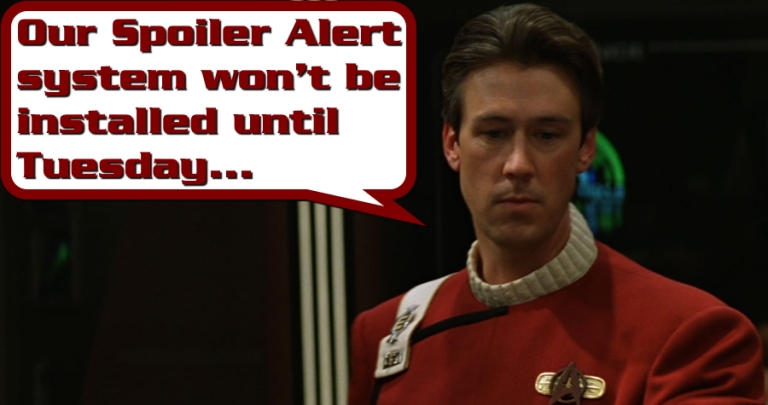
Spoiler Warning: There are spoilers ahead for Star Trek: Discovery Seasons 1-4, Star Trek: Picard Season 1 and the trailers for Season 2, Short Treks, Star Trek Online, and for other iterations of the Star Trek franchise.
Are you as curious as I am about Unknown Species 10-C? Right now, this is one of the biggest mysteries in Star Trek: Discovery’s fourth season – and one of the most tantalising storylines that the series has ever teased us with. We don’t have much to go on when it comes to figuring out who Unknown Species 10-C might be… but don’t worry, that hasn’t stopped me from putting together a list of suspects!
Part of me feels that because Discovery has teased us with so many references and callbacks to past iterations of Star Trek so far this season, Unknown Species 10-C will be someone we’re already familiar with. But at the same time, I keep thinking back to Season 3 and the Burn storyline, and how the ending to that story was something completely unpredictable and brand-new to the franchise. It wouldn’t surprise me to see Discovery go down that road again.

I successfully predicted that the dark matter anomaly – or DMA for short – was an artificial construct. Even though the DMA was initially teased as a scientific puzzle, it felt plausible verging on likely that Discovery would choose this direction for its main story, so I wasn’t stunned to get confirmation of that in the episode The Examples. The crew are now working on the assumption that the DMA is some kind of super-weapon… but that may not be the case. This is Star Trek: there’s always the possibility that this is an accident, an experiment gone wrong, or other such things!
Caveat time! I have no “insider information,” and I’m not trying to claim that any of the theories on the list below will pan out. I love being surprised by stories that go in unpredictable directions! This list is pure speculation from a fan of Star Trek, and nothing more. It’s also wholly subjective; if you hate all of my ideas or I don’t include your pet theory, that’s okay! We all have different ideas about what would make for a fun and exciting story, and there’s no need for fans to get into arguments about these kinds of things. This is supposed to be just for fun!
With all of that out of the way, let’s jump into the list – which is in no particular order.
Suspect #1:
The Borg Collective

In The Examples, Admiral Vance listed several factions that Starfleet Intelligence believed would have the technological capability to create the DMA. One notable omission from his list was the Borg Collective – and at this point, we don’t know why that is. The Borg’s technology (at least as of the late 24th Century) was light-years ahead of the Federation’s, and when I think about the most powerful factions in Star Trek and someone capable of creating something like the DMA, the Borg are quite literally at the top of my list.
Admiral Vance may know something that we don’t; the Borg Collective may not exist in the 32nd Century, for example. But the omission of the Borg from his list may be a misdirect, with Discovery’s writers trying to keep the faction hidden until the right moment. A conspiracy theory? Maybe! But it may yet pan out. There have been several direct references to Star Trek: Voyager in Discovery’s fourth season, and Voyager was the most Borg-y Star Trek series. That could be a possible hint!
The Borg are very powerful, capable of building a galaxy-spanning transwarp network and assimilating trillions of individuals across thousands of races. Their ships, weapons, and technology far outpaced the Federation as of their last appearance, and while the DMA wouldn’t necessarily fit with their usual method of attack, we can’t rule out that the Borg’s tactics have changed.
Suspect #2:
The Gorn Hegemony
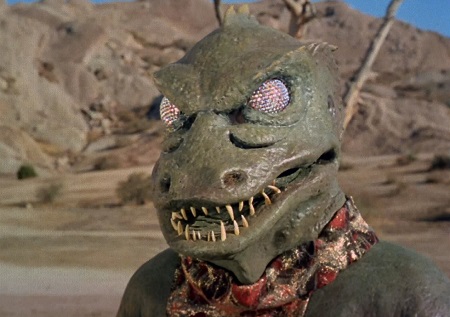
This stems from something we heard right at the beginning of Season 3 more than a year ago. In the episode That Hope Is You, Part 1, Cleveland Booker told Michael Burnham that the Gorn had “destroyed subspace” for several light-years in the area around the planet Hima. Clearly, then, the Gorn possess powerful weaponry in the 32nd Century, capable of damaging subspace – and we know that the DMA is capable of tearing subspace too.
This was a throwaway line – but it proves that the Gorn are still active in the 32nd Century, and that while the Burn may have impacted their society, it clearly wasn’t stopping them from conducting experiments or weapons tests – whatever it was they did that “destroyed” part of subspace. The Gorn have also been shown as antagonistic toward the Federation in their handful of appearances to date, meaning that they can certainly be argued to have motive.
On the production side of things, the Gorn are a relative unknown. They could thus be brought into a range of different stories in very different ways, allowing Discovery’s writers and producers a lot of wiggle room to tell the kind of story they want to tell while simultaneously harkening back to the very first season of The Original Series. Interestingly, Admiral Vance proposed the Metrons as one of the suspects on his list – and it was the Metrons who pitted Captain Kirk against the Gorn captain in Arena.
Suspect #3:
The Kelvan Empire
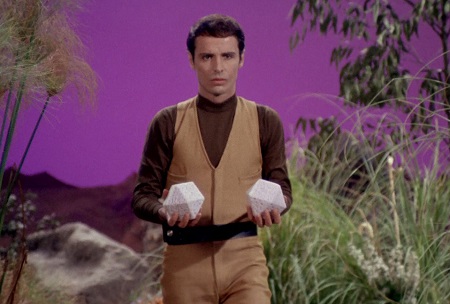
The Kelvan Empire’s first and only appearance to date came in the second season of The Original Series. A powerful faction from the Andromeda Galaxy, the Kelvan Empire was in search of a new home due to an environmental disaster – and they had their sights set on the Milky Way for conquest.
Captain Kirk was able to convince a Kelvan delegation that peaceful co-operation might be better, and promised Federation aid to help them find new worlds to settle. This offer was transmitted to the Andromeda Galaxy via an unmanned starship that would take centuries to complete the intergalactic voyage. Whether the leaders of the Kelvan Empire would be open to such co-operation, however, isn’t clear.
If the Kelvan Empire rejected the Federation’s offer and set out to conquer the Milky Way, the timelines kind of line up for this faction to return. In The Original Series their technology was incredibly powerful, giving them the ability to reduce organic beings down to their base minerals – then restore them to life – using a powerful field projection weapon. The Kelvan Empire was clearly far more advanced than the 23rd Century Federation, and may be capable of creating a weapon on the scale of the DMA.
Suspect #4:
The Dominion
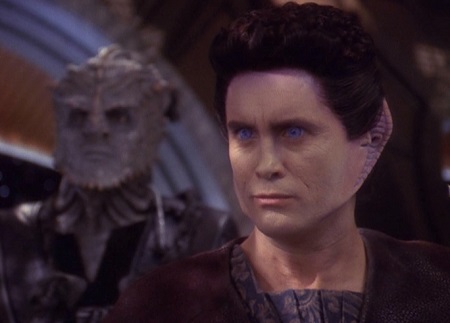
The introduction of Federation President Rillak – who is part-human, part-Bajoran, and part-Cardassian – has given us the first tidbits of information about what happened in the aftermath of the Dominion War. Though not stated outright, Captain Burnham’s comments in the episode All Is Possible seem to confirm that the Cardassians, Bajorans, and Federation have been at peace. But what of the Dominion?
The Dominion had existed for millennia prior to first contact with the Federation, and in many ways possessed technology that was at least slightly superior. It took the combined forces of the Federation, Klingons, and Romulans (with no small amount of help from the Prophets) to push the Dominion out of the Alpha Quadrant, so they’re clearly a strong and powerful faction. But after their defeat in the Dominion War, we don’t know what became of them.
Behind the Bajoran Wormhole, the Dominion may well have retained much of its territory. Perhaps, despite the best efforts of Odo, they sought to regroup and focused on developing new and powerful weapons. Or perhaps their dreams of peaceful coexistence were shattered by the Burn – an event emanating from Federation space and for which they may blame the Federation.
Suspect #5:
The Sphere-Builders
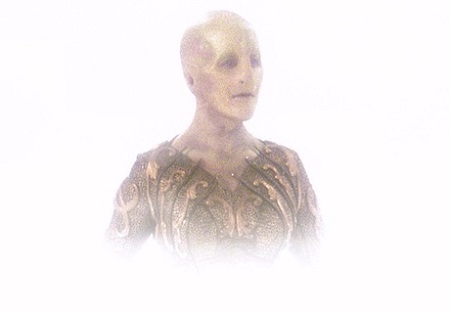
The Sphere-Builders were an extradimensional faction who fought in one of the Temporal Wars. They attempted to use a large network of spherical space stations in a region of space called the Delphic Expanse to convert a large swathe of the Milky Way to match their native realm; they were unable to survive in our dimension.
Crewman Daniels told Captain Archer that the Sphere-Builders were eventually defeated in the 26th Century, but it’s not impossible to think that they were able to rebuild in the centuries after that climactic battle. It’s also interesting to note that the scale model of the DMA controller that Stamets and Ruon Tarka built in the episode The Examples was spherical in shape.
The DMA isn’t a perfect match for what the Sphere-Builders were trying to do in Enterprise – but we still don’t know exactly what the DMA’s purpose is, and it may have some hidden function that we aren’t aware of yet. The Sphere-Builders were clearly a very powerful faction, capable of constructing huge self-powered space stations, meaning that the DMA is certainly something they would be capable of creating.
Suspect #6:
The super-synths from Star Trek: Picard
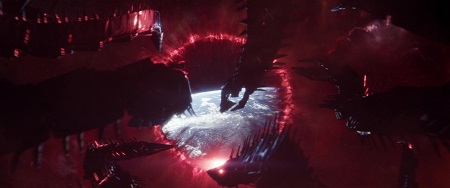
Because of the somewhat rushed ending to Picard Season 1, we never got to find out much about the faction I’ve dubbed the “super-synths.” Similar in some respects to the Reapers from the Mass Effect video games, this powerful alliance of synthetic life claimed to want to help other synthetics… but was their offer genuine?
The super-synths possessed very powerful technology, and when considering the DMA, which has powerful gravitational effects, one very important thing to note is that the super-synths have experience with gravity and with huge power sources. They were capable of literally moving stars, creating an artificial eight-star octonary system to serve as a guide for synths.
In the Picard Season 1 finale we caught a very brief glimpse of some menacing-looking synthetic tentacles… but that was all we saw. One thing I find very interesting in the aftermath of Picard Season 1 is that the super-synths may now be aware of the existence of the Milky Way, the Federation, the Romulans, and the Coppelius synths – potentially giving them a reason to come here.
Suspect #7:
The Klingon Empire
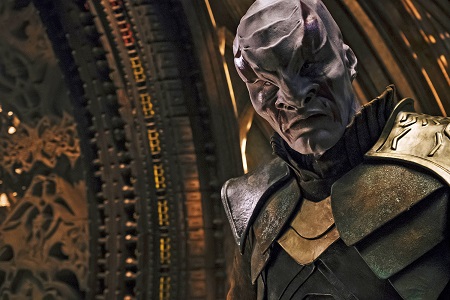
We haven’t heard so much as a growl from the Klingons since Captain Burnham and Discovery arrived in the 32nd Century, so we don’t know what became of the Federation-Klingon alliance that we saw in the late 24th Century. Did it endure? Did the Klingons perhaps even join the Federation at some point? Or did the two powers drift apart and resume their rivalry?
We’ve seen the Klingons as villains in Discovery before, during the Federation-Klingon War depicted in Season 1. It would be interesting in some ways to return to that, and as veterans of that conflict the crew of Discovery could play a key role in battling the Klingons if the Federation hadn’t had to fight them for a long time.
As above with the Dominion, the Klingon Empire may blame the Federation for the Burn. The DMA could be their way of retaliating – or beginning to retaliate. The DMA could be seen as a kind of artillery barrage, designed to soften up the Federation before a larger-scale attack or invasion. The Klingon Empire may well employ tactics like that.
Suspect #8:
The First Federation
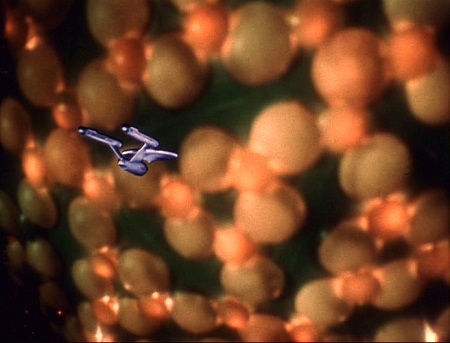
Another classic faction from The Original Series, the First Federation was first encountered by Captain Kirk in the episode The Corbomite Maneuver. The faction was clearly very powerful, possessing technology that far outpaced Starfleet in the 23rd Century. A single member of the First Federation was able to control a massive starship and disable the USS Enterprise during their first encounter.
The First Federation was implied to be much older than Starfleet and the Federation, and I’ve always had the sense that we only saw a fraction of the power Balok had at his disposal; the First Federation seem capable of far more destructive feats than we ever saw. Though relations with the First Federation seem to have been good, with trade happening well into the 24th Century, it’s possible that things changed.
The Burn is one potential catalyst for a souring of relations with the First Federation, and if they wanted to attack, they would appear to be more than capable of creating a weapon on the scale of the DMA.
Suspect #9:
Species 8472
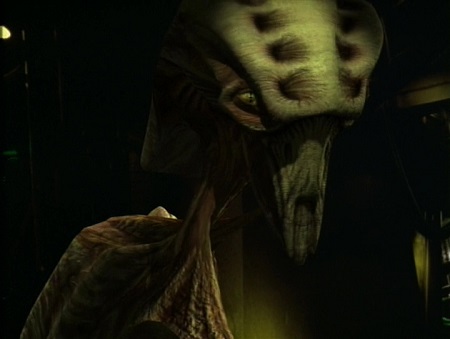
Species 8472 (also known in non-canon works as the Undine) are a race native to an extradimensional realm known as fluidic space. Fluidic space was notable for being entirely comprised of organic compounds, and Species 8472 were the only known native inhabitants. In the late 24th Century the Borg attempted to assimilate them – but they were able to fend off the attempt with ease.
There have been several references to Star Trek: Voyager in Discovery’s fourth season so far, so maybe those are teasing us with a more significant crossover! The last time the crew of Voyager encountered Species 8472 they were seemingly able to make peace… but was that peace destined to last?
Species 8472 were known to use organic technology that the Federation had a difficult time dealing with. They were also capable of creating non-organic technologies that could rival – or even surpass – 24th Century Starfleet, and they had the ability to change their forms so they could appear to be humanoid. We don’t know what became of Species 8472 after the events of Voyager – but in Star Trek Online they were a major antagonistic faction.
Suspect #10:
The Terran Empire
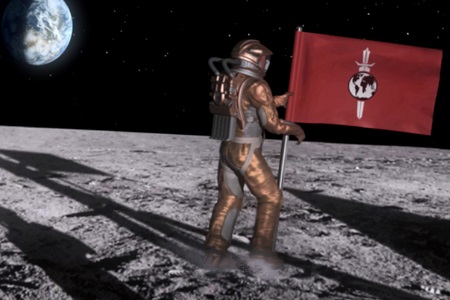
In the Season 3 episode Die Trying, Dr Kovich explained to Georgiou that it had been more than five centuries since there had been any contact between the Prime and Mirror Universes; the two universes had been slowly drifting apart. Perhaps the DMA is not so much a weapon as an attempt to re-open that link, one created by the Terran Empire – or their descendants.
The Terran Empire had fallen by the mid-24th Century, with Terrans being enslaved by the Klingon-Cardassian Alliance at that time. But it’s been a long time since then, and when we last saw the Mirror Universe, a Terran rebellion was in full swing. Perhaps over time the Terrans re-established their empire.
Alternatively, the Terran Empire of the 23rd Century could have attempted to break through to the Prime Universe, maybe intending to conquer the Federation. But for sci-fi reasons, instead of emerging in the 23rd Century they’ll emerge in the 32nd. After all, these kinds of technologies rarely work as intended in Star Trek!
Suspect #11:
The Q Continuum
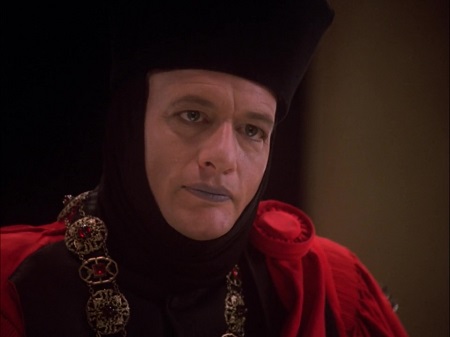
I wouldn’t have placed the Q Continuum under suspicion but for the fact that Admiral Vance rather nonchalantly mentioned them and then immediately ruled them out. Maybe they should be ruled out – this behaviour seems rather un-Q-like, after all – but what if it was a double-bluff from the writers?
Admiral Vance told us in The Examples that there had been no contact between the Q Continuum and the Federation for 600 years – but that doesn’t mean that the Q are gone. They’re essentially immortal and timeless, capable of travelling through time with ease. The fact that they haven’t been encountered for centuries is hardly odd under the circumstances – and no reason to rule them out altogether.
Q – by which I mean the individual who tangled with Captains Picard, Sisko, and Janeway – loved to tease and toy with humanity, but he always seemed to do so with purpose. Presenting humans with a puzzle to figure out wasn’t solely for Q’s amusement – he and the Q Continuum saw potential in humanity and in their own way sought to push us in a particular direction. Perhaps the DMA is another Q puzzle – and figuring it out will lead to some profound moment for Captain Burnham and the entire Federation.
Suspect #12:
V’Ger
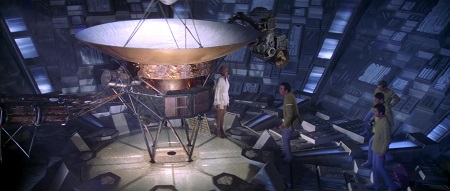
First encountered in The Motion Picture, V’Ger was a being of immense power – unparalleled at the time, and far beyond the scope of many civilisations. Much like the DMA, V’Ger was also massive in size, weighing in at a whopping 2AU – double the distance from the Earth to the Sun.
After its encounter with Admiral Kirk, Captain Decker, and Ilia, V’Ger evolved and disappeared – but at the end of the film, Captain Kirk very prominently chose to list Decker and Ilia not as “killed in action,” but simply as “missing,” hammering home the point that we don’t really know what became of them – nor of V’Ger itself.
The Motion Picture is one of my favourite Star Trek films for its deliberately slower pace and more ethereal storyline. The return of V’Ger after almost a millennium would be fascinating – where might it have gone, and what could it have learned in all those years? What were the outcomes of its merging with Decker and its evolution? These questions were left open as the credits rolled on The Motion Picture… maybe we’re about to get some answers.
Suspect #13:
Section 31
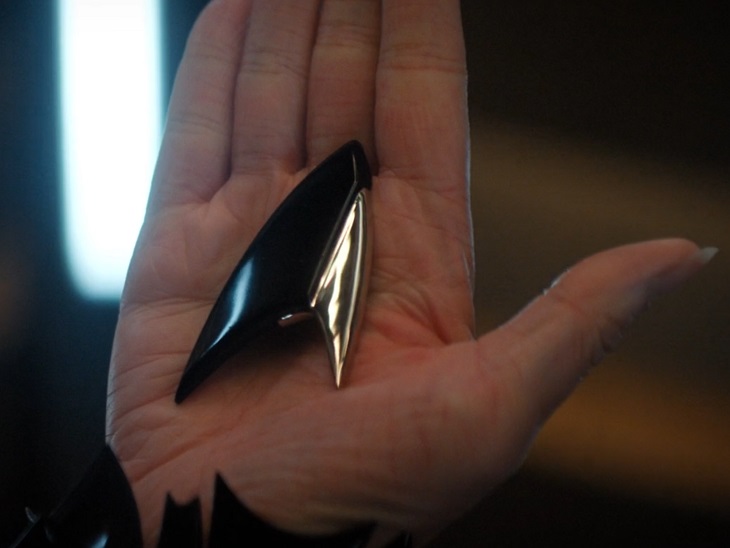
Section 31 is the off-the-books division of Starfleet Intelligence, a powerful but hidden faction that we’ve seen do some very questionable and even evil things on occasion. Section 31’s technology has always been depicted as being streets ahead of Starfleet’s – they got combadges in the 23rd Century, for example, decades before those communicators would be available to the rest of Starfleet.
A return to Section 31 would connect Season 4 back to the events of Season 2, which featured the shadowy organisation prominently in its storyline. Section 31 seems more than capable of creating something like the DMA – but at the moment we don’t know what motive they would have. If it was intended as a weapon, why target friendly worlds?
Perhaps the DMA is a Section 31 experiment or weapon that has gotten out of control – but this would arguably be too similar to the Control storyline from Season 2. Regardless, Section 31 seems quite capable of creating something like the DMA.
Suspect #14:
Dr Kovich

This is directly connected to the theory above, as part of me is still convinced that the mysterious Dr Kovich works for – or is perhaps the head of – Section 31.
Kovich’s presentation in Seasons 3 and 4 of Discovery is rather unusual by Starfleet standards. He seems to be skilled in a number of fields from psychology to intelligence, and we’ve seen him in a variety of different roles. The one thing his positions seem to have in common is power – he’s connected to Admiral Vance right at the head of Starfleet, he’s able to appoint Starfleet Academy instructors of his own accord, he’s seen debriefing powerful people for Starfleet Intelligence… the list goes on.
If Section 31 is involved with the DMA, I would bet money that Dr Kovich is, too. In fact, he isn’t really a suspect on his own unless Section 31 is behind the DMA, so we really have to take these two entries together!
Suspect #15:
The Control AI
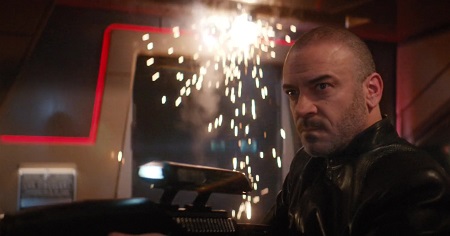
Control was the main villain during Discovery’s second season. A powerful artificial intelligence, Control coveted the Sphere data that now resides aboard the USS Discovery, believing that merging its programming with the data would allow it to achieve true sentience. It became murderous during its single-minded pursuit of the Sphere data – and is responsible for Captain Burnham and the crew travelling forward in time.
The exact circumstances of Control’s defeat are somewhat muddled, and the Season 2 finale seemed to imply that the death of Leland – who had been “assimilated” by Control’s nanites – crippled or even killed Control. Its servers will have been taken offline by Captain Pike, Ash Tyler, and the survivors of the battle… but could there be a way for Control to have survived?
From a storytelling point of view, there’s something interesting about a narrative that comes full-circle. Defeating Control saved the future – but perhaps its defeat was less final than we might’ve thought. We still don’t really know why Control wanted to exterminate all sentient organic life in the galaxy, either – was there a flaw in its programming, or was there something else going on?
Suspect #16:
Zora
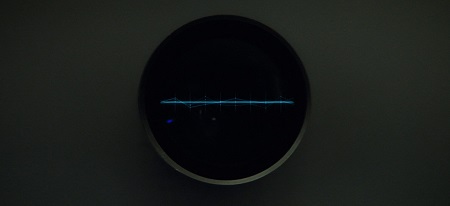
Sticking with an AI theme, we first met Zora in the Short Treks episode Calypso. Zora was created by the merging of the Sphere data with the USS Discovery’s computer, and we’ve since had several very interesting moments with Zora making decisions independently.
In the episode There Is A Tide, Zora teamed up with Tilly and the bridge crew to help retake the USS Discovery and defeat the Emerald Chain. But was this as altruistic as it seems – or was it simply the AI’s attempt at self-preservation? The mere pursuit of the Sphere data was enough to send Control into a murderous rampage… and the truth is that Captain Burnham and the rest of Starfleet simply don’t know what the long-term effects will be of the Sphere data’s merger with Discovery’s computer.
In The Examples we learned that Zora has begun to develop emotions – and emotions can lead to instability, especially when brand-new. Look at what happened to Data, for example, when he first received his emotion chip. Or look at Lore and Sutra as examples of AIs with “evil” personalities.
Suspect #17:
A faction from the Temporal Wars
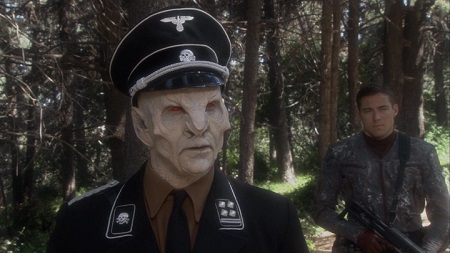
Season 3 introduced us to the Temporal Wars, a series of conflicts that wrapped up in the years prior to the Burn. The Temporal Cold War – which seems to be connected – was depicted in Star Trek: Enterprise, with the time-travelling Crewman Daniels enlisting Captain Archer’s help on several occasions.
There have been several references to Enterprise this season, with the familiar musical sting from Archer’s Theme bringing a tear to my eye in the episode Kobayashi Maru. Perhaps these callbacks have, in fact, been teasing something big in the story that lies ahead?
There are several different factions that participated in the Temporal Cold War that we saw in Enterprise, and the Temporal Wars themselves may well have introduced others. Any of these could be implicated in the DMA – it may represent an attempt to weaponise time travel and circumvent the time travel ban.
Suspect #18:
The United Federation of Planets
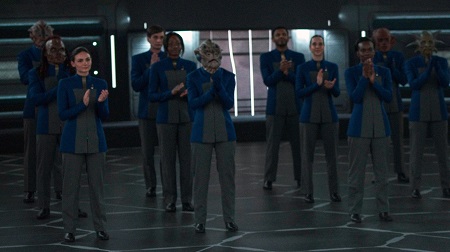
I don’t believe for a moment that the Federation would deliberately create the DMA as a super-weapon. Section 31 absolutely would, but not Starfleet. However, the DMA may not be a weapon. One thing Discovery has come back to time and again since Season 3 is the dilithium shortage. The discovery of the Verubin Nebula may provide a short-to-medium term fix, but eventually the galaxy is once again going to run out of dilithium; it’s a finite resource.
In addition to the SB-19 project that we heard about in the episode Unification III, we’ve heard of several other Federation experiments to create alternatives to warp drive – some of which are still ongoing as of Season 4. The DMA appears to have some kind of connection to wormholes, as it was able to disappear and reappear more than a thousand light-years away in an instant. What if the DMA is an out-of-control experiment?
If this is the case, we’d expect someone to realise what was happening sooner rather than later. But it would be a very interesting story indeed if the DMA was the Federation’s responsibility – even if they didn’t intend to unleash it.
Suspect #19:
President Laira Rillak
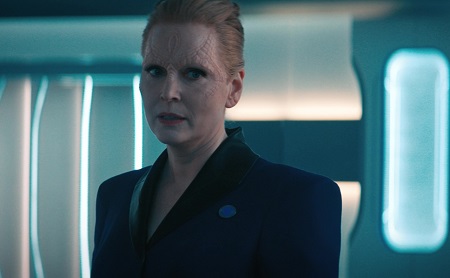
President Rillak is a wonderfully complex character who’s made a fine addition to Discovery. She’s also the kind of hard-nosed politician whose schemes border on the Machiavellian. Despite a recent détente with Captain Burnham, be under no illusions: President Rillak will happily throw Burnham and the USS Discovery under the bus if she believes doing so will suit her purposes.
A leader like that might very well sanction a dangerous experiment if she believed doing so would be to the Federation’s advantage. Maybe the DMA was intended to be a defensive weapon, maybe it was intended to destroy a threat to the Federation’s very existence, or maybe it was an attempt to travel faster-than-light without dilithium. Regardless, if such an experiment got out of control, you can bet your boots that President Rillak would try to cover it up.
If we think even more cynically – like a Covid-denying, flat-earther conspiracy theorist – maybe President Rillak ordered the creation of the DMA on purpose. Re-unifying the Federation is her main goal, and one way that people are known to come together is in the face of imminent danger. By unleashing the DMA onto the galaxy, perhaps President Rillak sought to bring ex-Federation members back into the fold. If so, it’s already paying dividends for her.
Suspect #20:
Ruon Tarka (and Paul Stamets)
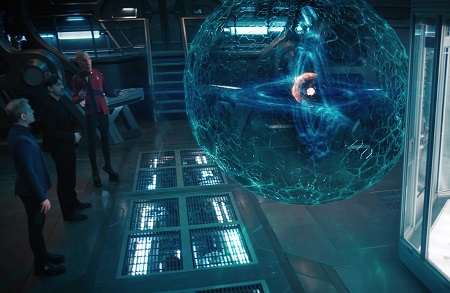
In the episode The Examples, Tarka and Stamets constructed a scale model of the DMA for research purposes – and according to Reno, came very close to destroying the entire ship. If they continue these experiments, perhaps they’ll end up creating the DMA by accident.
In order for this story to come to pass, we’d have to go down the dreaded time-loop route – and personally I really don’t like time-loop paradox stories! So I have to admit that I’m not too keen on this one… but that doesn’t mean it isn’t a possibility!
Because we know that the DMA has some kind of impact on spacetime, as well as potentially containing a wormhole, the prospect of time travel arises. It doesn’t seem impossible, based on what we know at this stage, for the DMA to travel backwards through time, perhaps emerging months in the past – kicking off the events that would lead to its own creation. It would be a complicated story, and one that would be difficult to get right, but we’ve seen Discovery tackle time travel on multiple occasions already.
Suspect #21:
Admiral Picard and the crew of La Sirena

Star Trek: Picard Season 2 is going to have a major time travel element to its storyline, with Picard and his new crew seemingly intent on chasing Q back to the 21st Century. If there’s one thing you can rely on in Star Trek it’s this: time travel seldom goes according to plan!
Admiral Picard would never willingly unleash something like the DMA… unless he had no choice. But if it was an unintended consequence of time travel gone wrong, maybe it’s possible that he and the crew of La Sirena are responsible. Perhaps Captain Burnham and the USS Discovery will break through to the centre of the DMA to find La Sirena sitting there.
If Picard Season 2 unfolds as its trailers suggest, the Admiral and crew will travel back in time to the 21st Century in order to “save the future” from whatever’s gone wrong to damage the timeline. But after their adventures in 21st Century Los Angeles they’ll have to get home – and it’s the return trip that could go awry, somehow sending the DMA – and perhaps them along with it – into the 32nd Century. A long-shot? Maybe. But it would be so interesting to see a proper crossover between Picard and Discovery.
Suspect #22:
Captain Michael Burnham

Captain Burnham has done nothing wrong, and there’s nothing at all in the story to suggest she would intentionally or unintentionally unleash something like the DMA upon the galaxy. But this is Star Trek: Discovery – so there’s always a chance that the show will put Captain Burnham at the centre of its main story!
The only way to really pull this off without dragging Captain Burnham’s character through the mud would be to have the responsibility lie with a parallel universe version of her, or perhaps some kind of evil clone. I don’t necessarily consider these to be likely, but with Discovery and Burnham, I don’t think we can entirely rule it out, either.
From a narrative perspective, having Burnham being in any way responsible for the DMA would have significant implications for practically all of the main characters – especially Book, whose homeworld was destroyed in the episode Kobayashi Maru. Would he hold her responsible, even if the blame lay with someone from an alternate reality?
Suspect #23:
The Red Angel suit
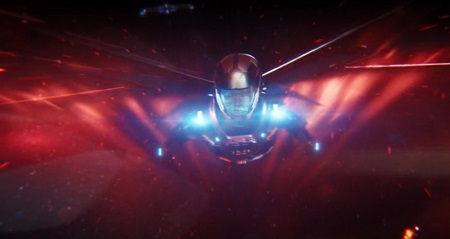
The Red Angel suits were powerful time-travel machines created in Season 2. The first Red Angel suit took Dr Gabrielle Burnham to the 32nd Century, and from there she used it to make numerous interventions back in time, trying to thwart Control. The second suit was built by the crew of the USS Discovery and used by Captain Burnham to lead the ship into the future.
One of the key similarities – at least on the surface – between the Red Angel suits and the DMA is the presence of something akin to a wormhole. The DMA – according to Stamets and Ruon Tarka, anyway – may contain a synthetic wormhole of some kind, and what did the Red Angel suit create at the end of Season 2? A time-wormhole.
For a 23rd Century device, the Red Angel suit was incredibly powerful, capable of dragging an entire starship in its wake. With some modifications, perhaps, or increased power, who knows what it might be capable of? This would be a way to connect the DMA to Captain Burnham without making the damage it’s caused her fault.
Suspect #24:
Independent Earth

Season 3 took the crew back to Earth – but the planet was not how they expected to find it! In the aftermath of the Burn, Earth had withdrawn from the Federation and was pursuing a policy of aggressive isolationism. Though Saru, Burnham, and the rest of the crew were able to help patch up relations between Earth and a human colony on Titan (which was referenced in the Season 4 episode All Is Possible) there was no indication that Earth was willing to abandon its independent status.
The Season 3 epilogue told us that Trill had rejoined the Federation, and in Season 4 we’ve also seen Ni’Var come back into the fold. But there hasn’t been any mention of Earth – as far as we know at this stage, its self-imposed isolation from the wider galaxy continues.
It’s possible that the leaders of Earth might’ve built a super-weapon for defensive purposes, but equally they could’ve been experimenting with faster-than-light travel or power generation, and the DMA is an experiment that got out of control. There could be an interesting allegory if Earth were to be identified as the culprits, leading to a story about the dangers of such an isolationist policy and trying to go it alone.
Suspect #25:
It’s alive!
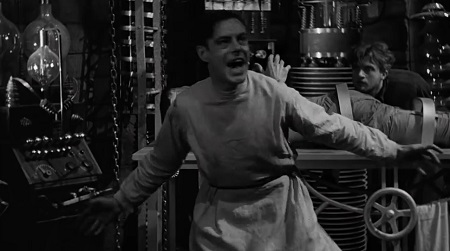
“They were only trying to communicate!” has become a Star Trek trope at this point, often used to describe how the seemingly-aggressive actions of an alien or entity were not intended maliciously. Perhaps the DMA, despite seeming to be artificial, is in fact a life-form in its own right.
We talked about V’Ger a moment ago, and the DMA could be something similar. Perhaps it was once an artificial construct, but has since become sentient. It may not have intended to cause harm or damage, but was simply exploring or even trying to make contact with the Federation.
This would be an inversion of the story we’re currently expecting. Instead of having a villainous enemy to defeat, Captain Burnham and the crew would instead make first contact with a very different life-form. Perhaps the DMA needs help, and despite the destruction of Kwejian and all the other damage it’s done, the crew would have to step up and offer assistance. There are many, many ways to make an interesting story out of this premise!
Suspect #26:
Someone entirely new

It could well be the case that, despite all of the callbacks and teases from past iterations of Star Trek, Discovery will introduce us to someone brand-new. This was the storytelling route taken by Season 3 with the Burn, and also in Picard Season 1 with the introduction of the super-synths. In both cases, a mystery that could have led us to a familiar faction ended up introducing us to someone entirely new.
As mentioned in the introduction, a big part of me feels that this is the way Season 4 will go. Any such faction or individual would naturally be impossible to predict – just like it would’ve been impossible to predict Su’Kal’s involvement with the Burn right up until his introduction near the end of Season 3.
Having had so many references and callbacks to past iterations of the franchise, and with Discovery practically begging us to theorise and speculate about the DMA and Unknown Species 10-C, it might end up feeling a tad anticlimactic if we once again get someone brand-new that we couldn’t have anticipated. But we’ll have to wait and see, and try to keep a lid on the disappointment if the series ultimately ends up here.
So that’s it.

We’ve listed a whopping twenty-five possible suspects – and maybe you can think of more! Who would be the weirdest, most left-field culprit that you could think of? Ensign Mariner from Lower Decks, perhaps? Or how about Grudge the kitty cat?
The DMA and Unknown Species 10-C have piqued my curiosity right now, and I truly can’t wait for Friday’s episode to see what other clues we might get. In a way I hope I haven’t guessed the culprit already so that Discovery can continue to take me on a wild and unpredictable ride! Season 4 has been great so far, and its central mystery has proven truly interesting. Hopefully the resolution to the story will do justice to an engaging mystery that has been carefully crafted and beautifully set up.
Star Trek: Discovery Season 4 is available to stream now on Paramount+ in the United States, Scandinavia, Latin America, and Australia. The show is on Pluto TV in the UK, France, Germany, Italy, and other parts of Western Europe at 9pm on Fridays and Saturdays. Individual episodes or the full season can be purchased on iTunes, Amazon Video, and possibly other platforms in the UK, parts of Europe, and select other countries. The Star Trek franchise – including Discovery and all other properties mentioned above – is the copyright of ViacomCBS. This article contains the thoughts and opinions of one person only and is not intended to cause any offence.

